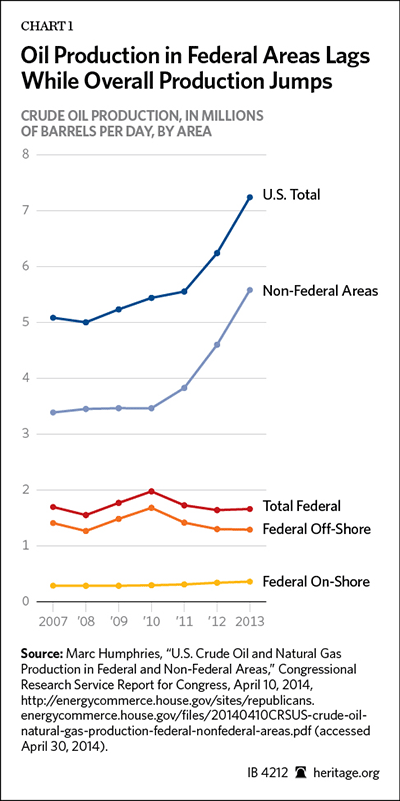Production of crude oil in the United States is up to 8.36 million barrels per day—the highest since January 1988.[1] The increased supply of oil has widespread economic benefits, but a new Congressional Research Service report shows that when the numbers are broken down by ownership it becomes clear that the situation could be even better. Although oil production overall has almost doubled in less than six years, production continues to fall on federally owned land areas.[2]
A more streamlined and efficient environmental review and permitting process would be welcome, but the best solution would be for Congress to devolve energy production decisions regarding federal lands to the states.
Offshore Drilling Discouraged
After oil production reached a peak in barrels produced offshore per day in 2010, the Deepwater Horizon oil spill resulted in a blanket moratorium on all new offshore projects and the cancellations of several existing leases. There may no longer be a literal ban on offshore drilling, but government policies still in effect have the same consequences.
It can take anywhere from five to 10 years for a company to move from approval to production, with no guarantee that the permit obtained will lead to successful crude oil production. Much of this is due to copious amounts of regulation and red tape.[3] The time and labor needed to see this process through dwarfs the amount of time it takes other businesses to expand and grow in almost any other industry. On top of the inefficient and onerous regulatory process, the oil industry has access to just 15 percent of available offshore areas.[4]
Inaccessibility and unnecessary regulations inhibit economic growth in various parts of the country off the Atlantic, Pacific, and Gulf coasts. A study recently published by the American Petroleum Institute and the National Ocean Industries Association shows that opening up offshore areas for drilling in the Atlantic Outer Continental Shelf—just one region where offshore drilling is possible but not permitted—would create 280,000 jobs in that region alone.[5]
Drilling on Federal Lands Faces Bureaucratic Hurdles
In addition to a continued decline in offshore drilling, onshore drilling on federal land has increased at only a fraction of the rate as on non-federal lands. Almost all of the benefits from fracking thus far have occurred on non-federal land.
While production on state and private lands has grown by almost 65 percent in the past seven years, production on federal lands has increased by about 27 percent, less than half the rate.[6] In total, federal lands now account for only 5 percent of oil production.[7] Daily federal onshore oil production is equal to about one-third of what is produced every day at the Bakken formation alone.[8]
Part of the discrepancy is that many of the big oil shale reserves lie on non-federal lands; however, a major reason that production on federal land has lagged behind is not a matter of economic viability or location but rather inefficiencies on the part of the federal government.
As with offshore drilling, long processes resulting from government inefficiencies create an unnecessary burden on industry. In some cases, waiting for a federal permit can take 10 times longer than it does at the state level. In 2013, the average wait for the federal government to approve a request was 194 days,[9] compared to 27 days in North Dakota, 11 days in Texas, and 45 in Pennsylvania.[10]
Federal ownership disincentivizes production on non-federal lands located adjacent to or interspersed with federal lands. Since production on federal lands is much more difficult, drilling may make economic sense only if a company has access to both the federal land and the non-federal land.
Open Access and Grant States Control
Excessive regulations and bureaucratic inefficiencies have stymied oil production and prevented the full effects of the energy boom. Opening up the rest of the Outer Continental Shelf to exploration and oil production would allow this to occur.
As the experience with federal lands that are technically open to exploration and drilling has indicated, having access is only one of the changes that must be made. Another step the federal government needs to take to allow for growth is to reduce time-consuming and costly regulations by streamlining the process. The efficiency that has been demonstrated at the state level shows that it is possible to quickly process a high volume of requests.
In fact, one of the primary reasons shale oil and shale gas production has been so successful both economically and environmentally is state management. State regulators and private land owners have decentralized knowledge and the proper incentives to promote economic growth while protecting their environment. They are the ones who have the most to gain when the management of natural resources and economic activity is handled properly, and theyalso have the most to lose if those are mismanaged.
The federal government owns nearly one-third of U.S. territory. Congress should consider privatizing some of that land, but in the meantime, transferring the management of federal lands to state regulators would encourage energy resource development on the federal estate while maintaining strong environmental protections. The Federal Land Freedom Act of 2013 (S. 1233 and H.R. 2511), introduced by Senator James Inhofe (R–OK) and Representative Diane Black (R–TN), would do just that by allocating more authority to the states to control their energy future.[11]
Increasing Energy Opportunities
Due to a lack of access and excessive federal regulation, the full effects and potential of America’s energy boom have yet to be felt. Streamlining and simplifying the approval process by devolving decisions to the states, along with opening up more regions for development, would allow the U.S. to harness its full energy potential.
—Nicolas D. Loris is Herbert and Joyce Morgan Fellow in the Thomas A. Roe Institute for Economic Policy Studies at The Heritage Foundation. Mallory Carr, a member of Heritage’s Young Leaders Program, contributed substantially to this report.


